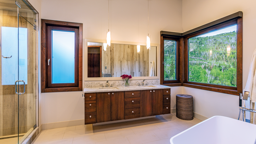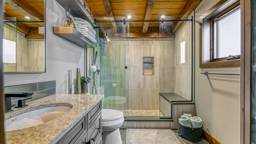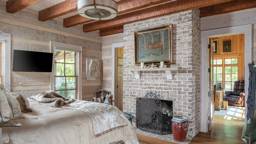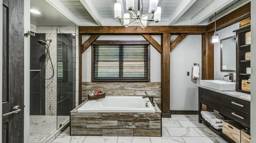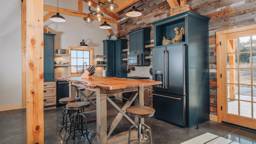
If you're thinking of building your own timber-home cabin or cottage, you'll need to be smart about your home's final design. We asked four industry experts to share their smartest tips for creating a timber home that features less space without sacrificing an inch of style.
Main Living Areas
1. Forgo the Formal Entry.
“The entry in a smaller house should be part of the larger space — it does not need to be formal and certainly shouldn’t interfere with the traffic flow of the home,” says Jim Driesch, Director of Design at Timberpeg in Claremont, New Hampshire. To accomplish this, the space should be just large enough to greet guests and provide ample storage, such as a coat rack and bench for removing shoes.
2. Create a Flexible Design.
Combining the living, dining and kitchen spaces in a smaller home is a smart idea. These areas do not need to be overly large to work well, and when part of an open plan they’ll “borrow” the illusion of space from the adjoining rooms, explains Driesch. Marty Birkencamp, designer at M.T.N. Design in Meridian, Idaho, agrees, and recommends eliminating formal spaces altogether.
“In these cases, never incorporate a formal dining room — always do a casual dinette off the kitchen,” he suggests. “You could even do built-in nook-style seating rather than designing enough space for a table and chairs. A small dining area can expand into the great room on holidays then retreat to its daily size for everyday use.”
3. Add Personal Spaces.
“Including a desk in a laundry room or kitchen verses a separate den or office, or a reading niche that is adjacent to a larger room, can squeeze in a functional or special space without adding an entirely separate room,” says Birkencamp.
To create a sense of privacy, he suggests tucking a small seat into your frame with a small window for a personal view to the outside.
4. Size Down Your Hearth.
Rather than make room for a soaring hearth in your main living area, opt for a gas or wood-burning stove instead. “These types of models can be used as a back-up cooktop, while conserving space and being more energy efficient than most fireplaces,” says Birkencamp.
Private Spaces
5. Eliminate Bathrooms.
“Many customers come in looking for three-bedroom designs where each bedroom has its own bath, plus an additional powder room. That is difficult to fit into a 2,500-square-foot or less home,” explains Jonathan Orpin, owner of New Energy Works Timberframers that has offices in New York and Oregon.
Instead he suggests incorporating a “family bath” for each floor. “The need for privacy and heavier traffic times can be mitigated by partitioning the more private functions like shower or toilet behind a pocket door, and having a powder room available elsewhere.”
6. Or Rethink Bathrooms Altogether.
Rather than putting in multiple bathrooms, you can always take a page out of the hotel industry’s playbook and put the toilet and shower in a separate compartment and put a sink or vanity in each bedroom, suggests Birkencamp. “Speaking of vanities, forget them! Instead, use a pedestal sink and create a full-length storage cabinet in the stud cavity next to the sink,” he adds.
7. Downsize Bedrooms — Not Storage.
Bedrooms have grown smaller over the years as more people realize that the greater return on their square foot investment might be in other areas, like the living room and kitchen, explains Orpin. If you’re working with smaller bedrooms with sloped ceilings or unique shapes, remember that those design “challenges” can actually present possibilities in the form of added closets or storage areas in those unused spaces.
8. Incorporate a Bunk Room.
Don’t underestimate the power of a well-designed sleeping loft or bunkroom filled with multiple beds, says Birkencamp. “These spaces are easy to close off when they’re not in use, and they allow for fewer separate guest bedrooms while still providing plenty of sleeping space in a fun bonus room.”
Storage
9. Design for Double Duty.
In a smaller home, you’ll want every space to be as functional as possible, says Ray Lefebvre, Director of Design at Woodhouse in Mansfield, Pennsylvania. “A wider hall can become a home office or mudroom. A bigger stair landing can transform into that cozy nook you always dreamed of, and the guest closet can include an open bench with hooks and a mirror for added storage,” he suggests.
10. Make the Most of Your Closet.
“We almost always incorporate a walk-in closet, for it allows us to perfectly match the clothing needs with the user with varying height hanging racks, shoe cubbies and built-in drawers. This also allows the now smaller master bedroom to stay clear of dressers, for a cleaner, calmer feel,” says Orpin. Remember: You also can include a stacked washer and dryer in a walk-in closet to eliminate the need for a full laundry room.
11. Be Efficient in the Kitchen.
As the most used space in the home, it’s especially important to make the kitchen work efficiently regardless of its size. A walk in pantry, even a small one, can concentrate much of the food and auxiliary kitchen needs into an easily accessible and relatively inexpensive space, allowing the kitchen to be a bit smaller and more open to the common area shared by living, dining and cooking activities, says Orpin. Also Birkencamp suggests focusing on smaller, more compact, appliances in the kitchen. “Try not to use wall ovens and cook tops,” he says. “Combine these into one and consider getting a convection microwave that will act as a secondary oven.”
Whole-House Ideas
12. Be Honest About Your Needs.
“When building a smaller house (less than 2,500 square feet, for example), the first thing families need to do is be brutally honest with themselves about how much space — and how much stuff — they really need,” says Lefebvre. “Many people have already accepted the open-plan concept, but I still see master bedrooms, baths and closets big enough to waltz in. If everyone took inventory of how much stuff they really need, they’d probably find a lot of extra space!”
13. Eliminate Hallways.
When planning, try to eliminate interior hallways whenever possible. “Circulating along the outside walls and eliminating corners makes a space feel much bigger — Frank Lloyd Wright was a master at this,” explains Lefebvre. “If you need hallway space for displaying objects, design the house to dedicate one wall in each room for art and pictures, bookshelves, etc., and leave the rest as empty as possible to eliminate visual clutter.”
14. Bring in the Light.
“Casting light on the walls and in corners instead of in the middle of the room can make the space feel bigger,” says Lefebvre. You can also add windows at ends of hallways, glass doorways or large window groupings in the great room so you are constantly looking beyond the structural limitations,” says Orpin. He also recommends using open staircases within the design. “Being able to see through a staircase and also allowing natural light to pass from one level to the next will greatly increase the openness of the home,” he adds.
15. Look Up.
Perhaps the simplest way to give the illusion of space in your home is to pay attention to the leading lines in the frame. “Just like leading lines in photography add depth to a 2d image, a timber frame has many lines that can create similar effect,” explains Birkencamp. Use those lines to create diagonal views that focus on the longest part of a room. For example, if you create a line of sight from the front door and seeing the opposite corner of the first floor the home will automatically feel larger. Also try to use 9-foot ceilings where flat ceilings are going to be used, otherwise focus on using vaulted or cathedral ceilings where possible to give the home a larger feeling of openness.
10 Extra Tips for Cozy Spaces
-
Investing in furniture that serves many functions is a great way to streamline a room. An ottoman with built-in storage lets you tuck away blankets and books, and also doubles as extra seating.
-
Dark colors can add drama to a space, but they also can make rooms appear smaller. The lighter the shade is, the more open your space will feel, so stick with neutrals and creamy shades.
-
While we wouldn’t recommend going overboard with mirrored surfaces, adding a little glass can open up an area and reflect light, making the space feel bigger.
-
In smaller homes, we often make the mistake of pushing the furniture against the walls to try to open up the room. But it’s smarter to give your furniture breathing room, whether it’s angling your bed or floating your sofa in the living room with a console table behind it.
-
Dining tables that can be made smaller or larger with removable or drop leaves let you make the most out of a combined living-dining area.
-
Rather than combine a bunch of different hues in one space, instantly expand a room by painting the walls, trim and detailing in different shades of one color, such as white, off-white or beige.
-
Bringing texture to your ceiling through colors, wood patterns and fun fixtures will draw your eye upward, creating the illusion of height in a room.
-
It’s easy to assume that oversized furniture will make a small space feel cramped, but you’ll actually create an airier atmosphere by displaying one prominent item — from a statement sofa to a curved armchair — rather than using multiple smaller pieces.
-
In a small homes, even your favorite accessories and knick knacks can quickly look cluttered unless you give them a little structure. Arranging collectibles, books and glassware by color will make everything appear more streamlined.
-
Leaving your windows uncovered (or opting for simple, streamlined window coverings) will trick your eyes into thinking that the space boasts added depth, while revealing the natural beauty of the surrounding landscape.




